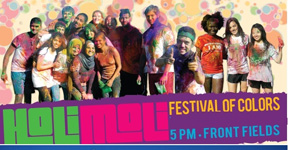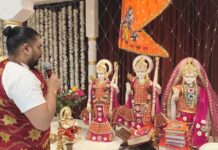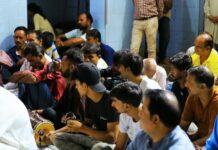
NORTH CAROLINA: A front ranking educational institution, the University of North Carolina at Charlotte (UNCC) hosted Holi, the Indian “festival of color.”
The Holi festival is not only celebrated across India but in this country too. Indian Americans in all major cities and towns do celebrate this festival of color with a lot of enthusiasm and fervor.
“It is an all-out good time with water guns and colors”, UNCC website states about “Holi Moli” event, which was sponsored by Campus Activities Board whose mission includes “to enhance and unify the university community” and whose advisors include UNCC Assistant Director of Student Activities. This free event held on March 18 on Front Fields near the main campus entrance starting five pm was participated by many.
The festival of Holi heralds the beginning of spring and starts about ten days before the full moon of Phalguna. Besides color play, ceremonies also include the lighting of the bonfires, during which all evils are symbolically burnt.
Holi also commemorates the frolics of youthful Lord Krishna; and celebrates the death of demoness Putana, burning of demoness Holika, and destruction of Kama by Lord Shiva. Holi fell on March 17 this year.
UNCC, public research university, founded in 1946 and spread in 1,000-acre campus, offers 21 Doctoral, 63 Master’s and 80 Bachelor’s degree programs to about 27,000 students. Karen A. Popp is Board of Trustees Chair while Philip L. Dubois is the Chancellor. Its tagline states that UNCC “prepares graduates to become active citizens of the world.”
Rajan Zed, President of Universal Society of Hinduism in a statement in Nevada pitched for all US and Canadian universities, public and private, should at least hold annual Hindu festivals of Holi and Diwali on the campuses in view of broadening presence of students and professors of Indian origin at the US universities.
This type of celebration will also help creating more awareness about other religions among non Indian students and fraternity which in turn will help make university students well-nurtured and enlightened citizens of tomorrow.
Citing Indian legendary poet Kavi Kalidas on Vasanta Ritu (The Spring Season), Kusum Vyas, Founder of the Green Kumbh Movement said “Gentle breeze, blowing from the south, softens the chilly air of the winter. The land comes to life as the flora suddenly bursts into maturity and young flowers bloom all over. The air is filled with intoxicating smell of fresh flowers and the effect is seen even on the cuckoo which is in an inebriated state”.
What’s so special about this celebration? First, because Holi is one of the most popular and ancient festivals in India. References to Holi are found in ancient paintings and murals and in sculptures on walls of ancient Hindu temples.
The tradition has continued uninterrupted for millennia. In India, while they share prayer and sumptuous food, the best part is the ritual of taking to the streets and splashing friends and even total strangers with dry colors, water balloons, sprayers and even, dousing them with entire buckets of colored water. On this day, everybody, old and young, is fair game.
While history and circumstances may have flung many Indians to the farthest reaches of the globe, they remain undiminished in their enthusiasm for festivals and rituals that define home.
Wherever Indian Diaspora lives in sizeable numbers, Holi is the same jamboree of myriad colors as in India. However, whenever Holi falls in the middle of working week, the Indian expatriate community celebrates the festival on a weekend closest to the actual date.
Madhu Patel






